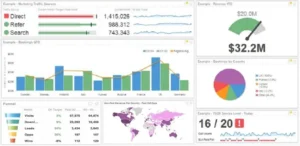Are you thinking about Salesforce as your primary CRM? Already decided on Salesforce and looking where to start? Congratulations! Not only in joining the world’s largest CRM platform for business growth but also for landing on this quick guide in preparation for your Salesforce implementation. The decision to choose Salesforce to run some of or all your business operations is a big one. Not only is the financial investment significant, but based on your specific business needs, implementation can be rather complex. However, following these easy initial steps when integrating Salesforce will guarantee your best foot forward- from early implementation to having Salesforce grow with you as far as you can take it.
PHASE #1
PARTNER, PARTNER, PARTNER, especially in the initial launch. We will say it’s never too late to bring in a Qualified Salesforce partnership to assist in any aspect of your business. We can’t stress enough the importance of seeking consultation when just kicking things off with Salesforce.
Well, of course, we’re going to say, “you need help from the experts.” Hello, Hi, we make our living by being those experts. Although we think we’re top-notch and would make an excellent fit for everyone’s Salesforce needs, it’s naive to linger on the thought of every prospect being an ideal match for both parties.
Whether with another Qualified agency or us, finding the right partnership for your specific business needs has to be crucial step #1 in the implementation journey.
Still don’t believe us? Take one of the most respected influencers in the industry’s word for it.
SalesforceBen quoted this in a recent article on some of his best Salesforce implementation advice.
Leveraging the knowledge and experience of a partner addresses a lot of the pitfalls associated with self-implementation. By getting instant access to several years of implementation experience, not to mention the internal network within the partner itself, you gain the ability to move not just quickly, but efficiently
What about advice directly from Salesforce?
Planning for successful adoption is a key part of any CRM implementation and can involve securing executive buy-in and approval, getting key team members to act as informal evangelists inside your organization, and running scheduled check-ins and training sessions. Working with an implementation partner experienced in these nontechnical aspects of deployment can make all the difference when it comes to successfully rolling out your own CRM solution.
“Qualified” can be an extremely loose term in dealing with professional partnerships. Due diligence is obviously going to be necessary when finding the right partner.
Salesforce has done some of the leg work by partnering with “Qualified” third-party companies specializing in various Salesforce disciplines. In addition, locating great companies such as Cloud Next Level, among many others, is made easier through the Salesforce app exchange.
PHASE #2
PLAN, PLAN, PLAN, Hopefully, going with a certified Salesforce expert as a partner was the ultimate decision in phase #1. They should more than make up the cost of their services during this phase. Don’t shy away from possibilities for your business based on complexities. There is someone or a group of someones in the Salesforce ecosystem that can help, we assure you of that
Start with a bird’s eye view of what “success” for the business will look like. Then we can narrow down on the avenues of approach in the now and far into the future. Building a CRM that can grow with you from the jump will avoid big pitfalls and roadblocks down the road.
So, we have an overall established goal, and all parties are on board. Fantastic! Now we can narrow down our focus to critical areas within the business and start building Salesforce systems for our specific application needs. It’s important to start small with a project and make sure all involved parties align with the overall goals for the department.
According to Salesforce MVP Tal Frankfurt,
Having executive sponsor’s full support and participation – from the planning stage until the go-live date and beyond – is absolutely critical.
Build from the inside out and deploy in phases. Get everyone comfortable and confident on the basics of your specific project from the start. Then, only roll out the next stage after a firm grasp is on the previous one. Doing so will allow for more efficient deployment in more complex phases down the road. In addition, testing and fixing bugs that arise during the process is much easier to resolve when more individuals have a complete understanding from the earlier stages.
Phase #3
EXECUTE, EXECUTE, EXECUTE. You’ve had a chance to work with a great Salesforce partner, working together to ensure the execution phase goes precisely as rehearsed. You’ve tested the plan, you’ve worked out the bugs in the project, you’ve built the system from the inside out, and all personnel are on the same page.
It’s all downhill from this point. If the first two phases were developed correctly, this phase should be overseeing the implementation. All of the hours of hard work spent in the first two phases will pay off now. (Proving once again how vital a Salesforce partnership truly is).
We can’t stay stagnant in our businesses. Even the most well-thought-out and executed implementation plans will need some adaptation over time. So, it’s imperative to have expansion capabilities built-in from the start and be comfortable enough to navigate these scenarios when they arise.
Your Salesforce partner should have placed you and your team down the path of CRM success. However, to help make sure you are always getting the most out of your Salesforce once rolled out, we need to consider two things.
- Training – some training at all levels across all disciplines has already taken place during the Salesforce implementation. It’s crucial to stay active and aware of new updates and changes across Salesforce to minimize any gaps in productivity. Consider corporate training to ensure you and your team are always up to speed.
- Managed Services – Although it’s a good idea to have familiarity with Salesforce and how it directly applies to the success of your business, Salesforce can be managed for you. Managed services can exponentially lower the workload in the day-to-day business operations. Daily management from professionals with years and years of experience is something to consider after the initial integration with Salesforce.
Conclusion:
Simplicity and clear-cut instruction can be a great fallback when tackling what seems to be complex and overwhelming projects such as an optimal Salesforce Implementation. Let this simple guide be the reference to reference when just getting started, or if you lose track along the way. The critical point to remember is not to go at this alone. Do the research, interview multiple candidates, and choose a great partner to exponentially increase your success with Salesforce.







